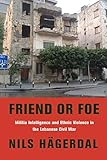Friend or Foe : Militia Intelligence and Ethnic Violence in the Lebanese Civil War / Nils Hägerdal.
Material type: TextSeries: Columbia Studies in Middle East PoliticsPublisher: New York, NY : Columbia University Press, [2021]Copyright date: ©2021Description: 1 online resourceContent type:
TextSeries: Columbia Studies in Middle East PoliticsPublisher: New York, NY : Columbia University Press, [2021]Copyright date: ©2021Description: 1 online resourceContent type: - 9780231553728
- 956.9204/4 23
- DS87.5 .H326 2021
- online - DeGruyter
| Item type | Current library | Call number | URL | Status | Notes | Barcode | |
|---|---|---|---|---|---|---|---|
 eBook
eBook
|
Biblioteca "Angelicum" Pont. Univ. S.Tommaso d'Aquino Nuvola online | online - DeGruyter (Browse shelf(Opens below)) | Online access | Not for loan (Accesso limitato) | Accesso per gli utenti autorizzati / Access for authorized users | (dgr)9780231553728 |
Frontmatter -- Contents -- Acknowledgments -- Introduction -- I Ethnic Violence in Non- Separatist Wars -- II The Lebanese Civil War, 1975– 1990 -- III Demographics, Migration, and Violence -- IV Lebanon’s Christian Militias -- V Palestinian, Muslim, and Left- Wing Armed Groups -- Conclusion -- Notes -- References -- Index
restricted access online access with authorization star
http://purl.org/coar/access_right/c_16ec
When civil conflicts break out in plural societies, violence often occurs along group divides—running the risk of spiraling into ethnic cleansing. Yet for militants who do not seek ethnic separation as a political goal, indiscriminate attacks are detrimental to their cause. Under what circumstances are such combatants more or less likely to commit ethnic violence?Nils Hägerdal examines the Lebanese civil war to offer a new theory that highlights the interplay of ethnicity and intelligence gathering. He shows that when militias can obtain reliable intelligence—particularly in demographically intermixed areas where information can cross ethnic boundaries—they are likely to refrain from indiscriminate tactics. Access to local intelligence helps armed groups distinguish between neutral and hostile non-coethnics to target individual opponents while leaving civilians in peace. Conversely, when militias struggle to access local information, they often fall back on ethnicity as a proxy for political allegiance, with bloody consequences. As intelligence capabilities shape the course of sectarian strife, the role of ethnicity can vary even within a particular conflict.Hägerdal conducted sixteen months of fieldwork in Lebanon, interviewing former militia fighters and commanders and collecting novel statistical evidence. He combines documentation by government agencies, NGOs, local news media, and the United Nations with firsthand narratives by participants to provide an unparalleled account of the processes that generate violence or coexistence when a diverse society descends into armed conflict. Theoretically innovative and descriptively rich, Friend or Foe sheds new light on the logic and dynamics of ethnic violence in civil wars.
Mode of access: Internet via World Wide Web.
In English.
Description based on online resource; title from PDF title page (publisher's Web site, viewed 01. Dez 2022)


